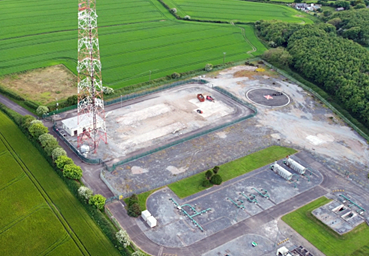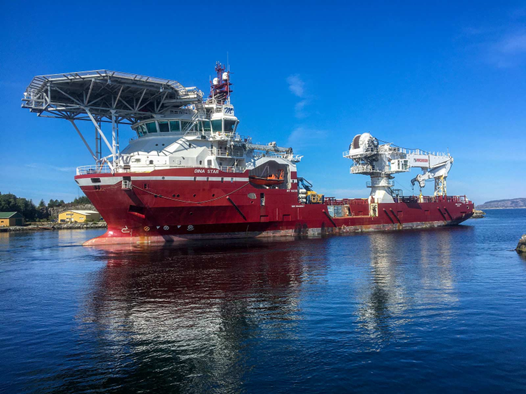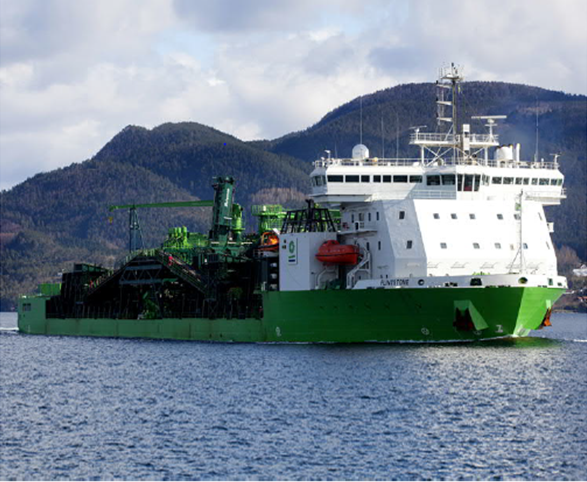DECOMMISSIONING
Why have we decommissioned
Gas production from the wells was shut in on the 5th of July 2020 when all the gas reserves in the various fields were depleted. All of the gas production wells have now been permanently plugged with cement and the associated facilities (platforms, pipelines, cables, subsea structures and onshore terminal) have also been decommissioned.
What was the Decommissioning Project?
Kinsale Energy developed a comprehensive plan to decommission all of the Kinsale Area gas fields. The offshore decommissioning activities were completed in July 2023, having commenced in July 2020. The onshore works at Inch Terminal works occurred over a much shorter period (less than 6 months) during 2022.
You can read more about our Decommissioning project HERE
Decommissioning Consent Applications
In June 2018, Kinsale Energy applied to the Minister for Communications, Climate Action and Environment for approval of Decommissioning Plans for some of the facilities in the Kinsale Head and Seven Heads gas fields, including:
– Platform and Subsea Well Abandonments
– Platform Topside
– Subsea Infrastructure
The following Consent Application documents are available on the website:
Decommissioning Plan – Kinsale Head
Decommissioning Plan – Seven Heads
Environmental Impact Assessment Report:
Vol 1 Non-Technical Summary
Vol 2 Main Report Sections 1-9
Vol 3 Main Report Appendices Parts 1 & 2
Appropriate Assessment Screening Report
The Department of Communications, Climate Action & Environment (DCCAE) issued approval of Consent Application No 1 to Kinsale Energy on 26th April 2019 and the approval letters can be viewed below. The approvals for both the Kinsale Head Gas field and the Seven Heads Gas field contained a number of conditions in relation to reporting, environmental management and so on and these conditions were incorporated in the planning for the decommissioning project.
Kinsale Head Plan of Development
Kinsale Head Screening Determination for Appropriate Assessment
Seven Heads Plan of Development
Seven Heads Screening Determination for Appropriate Assessment
In August 2019, KEL submitted a further application to DCCAE in respect of removal of the Kinsale Alpha and Kinsale Bravo platform sub-structures or jackets (Consent Application No 2) – this application covered complete removal of the jackets down to seabed level.
The Department of Communications, Climate Action & Environment (DCCAE) issued approval of Consent Application No 2 to Kinsale Energy on 26th Feb. 2020.
The approval letters from DCCAE can be viewed below:
Determination on Kinsale Decommissioning Plan
Determination on Kinsale AA Screening
October 2021 Submissions in relation to Subsea Pipelines & Umbilicals:
In October 2021, further Consent Applications were submitted to the Department of the Environment, Climate & Communications (DECC) and to the Environmental Protection Agency (EPA) in respect of the subsea pipelines and umbilicals for the Kinsale Head, Ballycotton and Seven Heads gas fields. These applications are for the retention of the existing pipelines and umbilicals in-situ on the seabed and for the installation of protective materials (rock berms) to guard against any snagging hazards which might pose a risk to fishing activity.
Further information in relation to surveys carried out as part of the proposed rock placement program was submitted to DECC on 28th January 2022.
Approval from the Dept. of Environment, Climate and Communications (DECC) in relation to these applications was received on 16th Dec. 2022 – see link below:
Dumping at Sea Act submissions:
The documents listed below were submitted to the Environmental Protection Agency (EPA) on Oct. 20th 2021 – these are for permission under the Dumping at Sea Act 1996 (as amended):
Kinsale Head DAS Application Form and Attachments
Seven Heads DAS Application Form and Attachments
Kinsale Area Decommissioning Project – EIAR Addendum No 2
These may be read in conjunction with the Project EIAR at the link shown under Decommissioning Consent Applications above.
The applications under the Dumping at Sea Act were approved by the Environmental Protection Agency (EPA) on 16th Feb. 2023 and Dumping at Sea permits were issued for the Kinsale Head and Seven Heads pipelines and umbilicals – see links below:
Kinsale Head: 090151b2808651c5.pdf (epa.ie)
Seven Heads: 090151b2808651ca.pdf (epa.ie)
Decommissioning Activities
2021
The final gas production from the fields occurred on 5th July 2020 and since then we have completed a significant program of facilities decommissioning and removal:
Well Plugging – there were 7 wells on each platform which were all drilled in the late 1970’s and had been operating continuously since then – their production equipment has now been removed and the wellbores have been filled with cement to ensure they are sealed for posterity. Following removal of the platforms in 2022, there is no trace of these wells remaining on the seabed.
Subsea Well Plugging – in addition to the platforms, there were production facilities installed underwater on the seabed, as all the smaller satellite fields developed between 1990 and 2003 utilised subsea technology. There were 10 subsea wells, which have been plugged with cement, like the platform wells – a specialised rig, the “Stena Spey” was used for this purpose and the work was completed in November 2021.
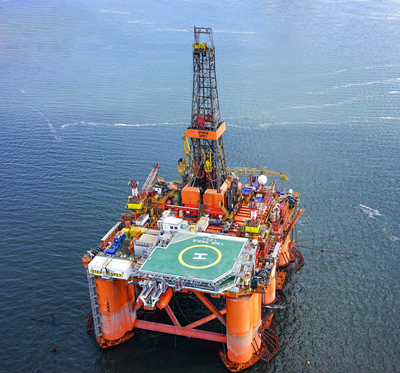
Subsea Infrastructure Removal – in addition to plugging and sealing the subsea wellbores, a large amount of infrastructure on the seabed has been removed – for example, steel and concrete protection structures, valve assemblies, piping manifolds and the like. A specialised marine contractor – Technip FMC – completed this work in 2 separate campaigns in May and August 2021, utilising a Dive Support Vessel (DSV) and a Construction Support Vessel (CSV). The equipment recovered has been taken to dismantling locations for eventual disassembly and recycling.
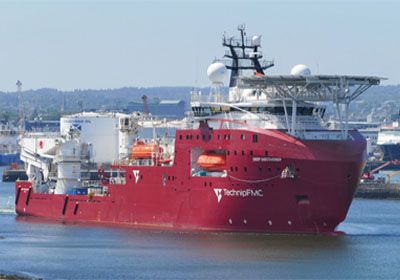
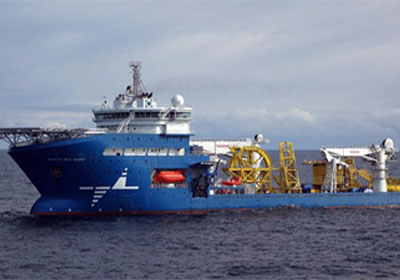
2022
The main activity undertaken in 2022 was the final removal of the two platform structures – Alpha and Bravo. This was undertaken by a floating crane vessel, the “Thialf”, one of the largest crane vessels in the world, which is operated by Heerema Marine Contractors of the Netherlands. As described below, the platforms have now been removed from their offshore location and have been transported to a dismantling yard in Vlissingen in the Netherlands for disassembly and eventual recycling.
Platform Removal
The first big milestone in the removal of the offshore platforms was achieved on June 1st – the Bravo topsides was removed in one lift by the THIALF from the jacket structure and transferred to the transport barge – the photos below tell the story.
Rigging on – Ready to lift:
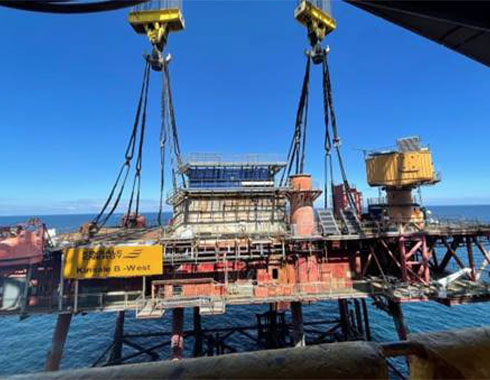
Topsides lift-off:
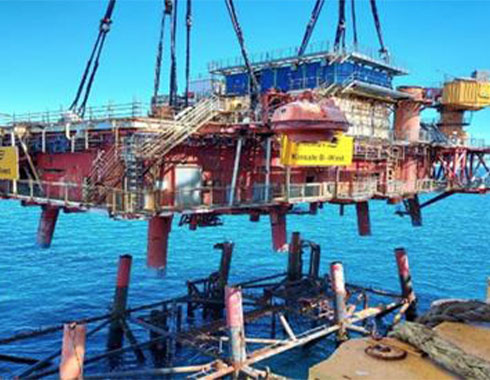
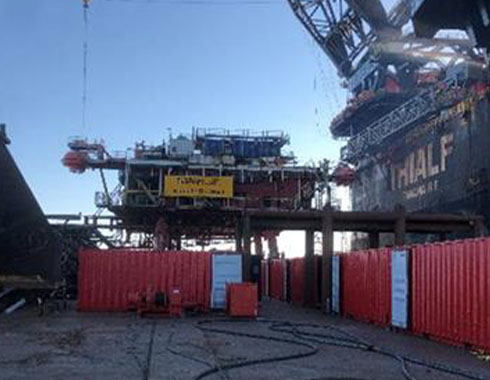
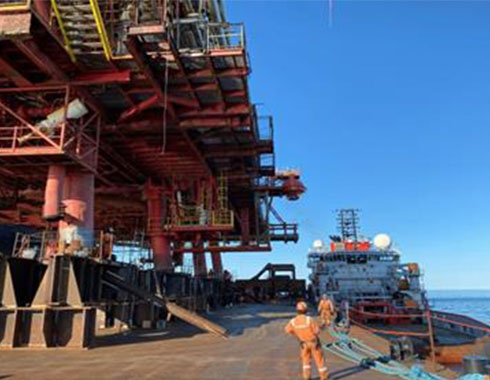
Subsequent to removal of the topsides, the supporting structure – the jacket – was removed by cutting and recovering the upper section and then removing the foundation sections.
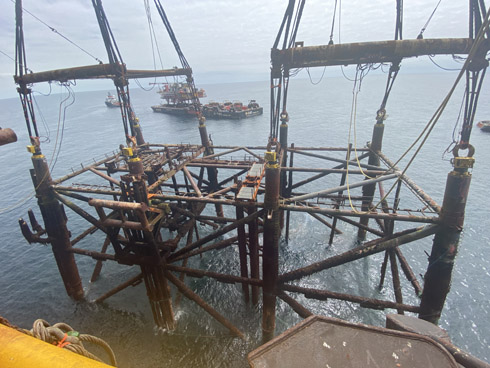
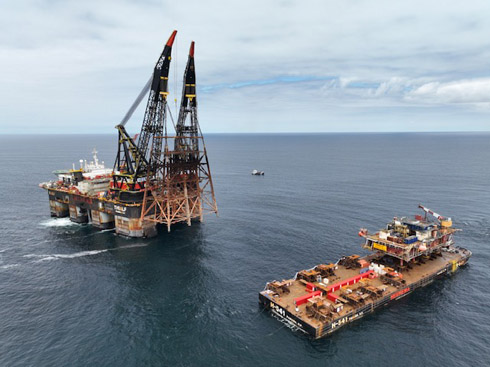
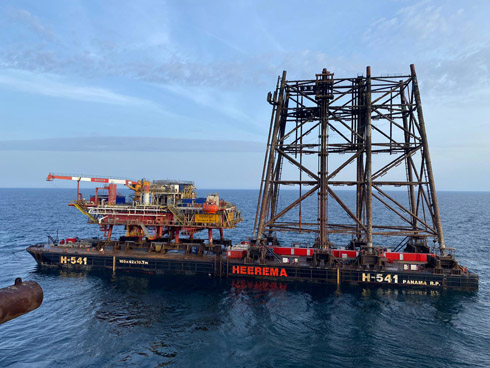
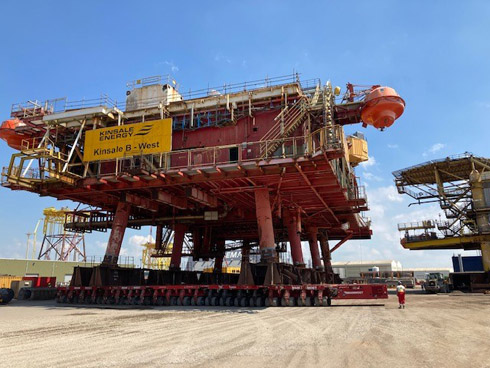
The entire process was then repeated for the Alpha platform and the crane barge completed operations and departed mid-Sept.
The weight of the topsides was 2,755 tonnes (the two accommodation blocks weighing 680 tonnes having been removed previously) and the upper jacket was a further heavy lift of 3,460 tonnes, making these some of the largest crane lifts ever carried out in Ireland.
Inch Terminal
Inch Terminal, located in East Cork was also decommissioned by May 2022, which involved the removal of all mechanical and process equipment from the site. The telecommunications tower remains in use as it supports a number of mobile phone providers.
2023
The final decommissioning activities occurred in 2023 – these were:
Post-decommissioning surveys:
A number of surveys were carried out on the sites of decommissioned facilities and pipelines to identify any debris or pipeline spans which might be hazardous to fishing or marine activities in the future. The results of these surveys were used to plan the final site clearance and rock placement activities. Several sediment samples were also taken to confirm that no contamination has occurred during the decommissioning program.
Debris removal and site clearance.
A Construction Support Vessel (CSV), the “Dina Star” operated by Deep Ocean Subsea Services undertook a campaign to remove any debris identified during the clearance surveys. This campaign was successfully completed in July 2023.
Placement of protective rock-berms on subsea pipelines and umbilicals being left in-situ:
Two specialised rock placement vessels, the “Flintstone” and “Rollingstone” operated by DEME bv, placed specially engineered rock berms at the ends of all subsea pipelines and in any areas where pipeline free-spans have occurred, which could be hazardous to fishing activity.
A post-decommissioning monitoring program will be put in place to ensure that no further protective measures are needed in the future.
These works will mark the end of a significant program of works lasting from 2020 which has been carried out safely and effectively with no significant environmental issues being recorded.
Decommissioning – Highlights
| Gas Production Finished: | July 2020 |
| Platforms De-manned: | August 2021 |
| Platforms Removed: | Sept. 2022 |
| Works Complete: | Sept. 2023 |
| No. of Wells Plugged and Abandoned: | 24 |
| Tonnage of Material Removed: | 28,000 tonnes |
| Percentage Material Reused/Recycled – Target: | >90% |
| Manhours expended: | 1,647,000 |
| Number of Offshore Vessels Used: | 36 |

